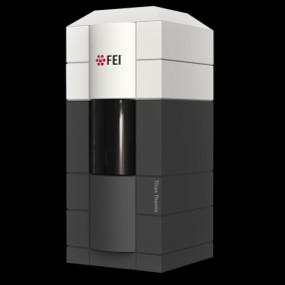[English] 日本語
 Yorodumi
Yorodumi- PDB-8opq: Structure of Human Solute Carrier 26 family member A6 (SLC26A6) a... -
+ Open data
Open data
- Basic information
Basic information
| Entry | Database: PDB / ID: 8opq | ||||||
|---|---|---|---|---|---|---|---|
| Title | Structure of Human Solute Carrier 26 family member A6 (SLC26A6) anion transporter in an inward-facing state | ||||||
 Components Components | Solute carrier family 26 member 6 | ||||||
 Keywords Keywords |  MEMBRANE PROTEIN / MEMBRANE PROTEIN /  Homodimer / Homodimer /  Transporter / Exchanger / Transporter / Exchanger /  Bicarbonate / Bicarbonate /  Chloride / Oxalate MEMBRANE PROTEIN Chloride / Oxalate MEMBRANE PROTEIN | ||||||
| Function / homology |  Function and homology information Function and homology informationsulfate:bicarbonate antiporter activity / formate transport / mannitol transmembrane transport / oxalate transport / formate transmembrane transporter activity / Multifunctional anion exchangers / oxalic acid secretion / sulfate transport / protein kinase C signaling / transepithelial chloride transport ...sulfate:bicarbonate antiporter activity / formate transport / mannitol transmembrane transport / oxalate transport / formate transmembrane transporter activity / Multifunctional anion exchangers / oxalic acid secretion / sulfate transport / protein kinase C signaling / transepithelial chloride transport / epithelial fluid transport / sulfate transmembrane transporter activity / secondary active sulfate transmembrane transporter activity / oxalate transmembrane transporter activity / intracellular pH elevation / cellular response to fructose stimulus / chloride:bicarbonate antiporter activity / solute:inorganic anion antiporter activity / vesicle membrane / transepithelial transport / bicarbonate transport / bicarbonate transmembrane transporter activity / intestinal absorption / chloride transport / chloride transmembrane transporter activity /  sperm capacitation / sperm capacitation /  chloride channel activity / efflux transmembrane transporter activity / chloride channel activity / efflux transmembrane transporter activity /  chloride channel complex / chloride channel complex /  estrous cycle / monoatomic ion transport / cellular response to cAMP / sperm midpiece / positive regulation of dipeptide transmembrane transport / establishment of localization in cell / estrous cycle / monoatomic ion transport / cellular response to cAMP / sperm midpiece / positive regulation of dipeptide transmembrane transport / establishment of localization in cell /  PDZ domain binding / angiotensin-activated signaling pathway / brush border membrane / PDZ domain binding / angiotensin-activated signaling pathway / brush border membrane /  regulation of intracellular pH / cytoplasmic vesicle membrane / cellular response to type II interferon / regulation of intracellular pH / cytoplasmic vesicle membrane / cellular response to type II interferon /  transferase activity / basolateral plasma membrane / vesicle / apical plasma membrane / transferase activity / basolateral plasma membrane / vesicle / apical plasma membrane /  endoplasmic reticulum / endoplasmic reticulum /  membrane / identical protein binding / membrane / identical protein binding /  plasma membrane / plasma membrane /  cytosol cytosolSimilarity search - Function | ||||||
| Biological species |   Homo sapiens (human) Homo sapiens (human) | ||||||
| Method |  ELECTRON MICROSCOPY / ELECTRON MICROSCOPY /  single particle reconstruction / single particle reconstruction /  cryo EM / Resolution: 3.28 Å cryo EM / Resolution: 3.28 Å | ||||||
 Authors Authors | Tippett, D.N. / Breen, C. / Butler, S.J. / Sawicka, M. / Dutzler, R. | ||||||
| Funding support |  Switzerland, 1items Switzerland, 1items
| ||||||
 Citation Citation |  Journal: Elife / Year: 2023 Journal: Elife / Year: 2023Title: Structural and functional properties of the transporter SLC26A6 reveal mechanism of coupled anion exchange. Authors: David N Tippett / Colum Breen / Stephen J Butler / Marta Sawicka / Raimund Dutzler /   Abstract: Members of the SLC26 family constitute a conserved class of anion transport proteins, which encompasses uncoupled transporters with channel-like properties, coupled exchangers and motor proteins. ...Members of the SLC26 family constitute a conserved class of anion transport proteins, which encompasses uncoupled transporters with channel-like properties, coupled exchangers and motor proteins. Among the 10 functional paralogs in humans, several participate in the secretion of bicarbonate in exchange with chloride and thus play an important role in maintaining pH homeostasis. Previously, we have elucidated the structure of murine SLC26A9 and defined its function as an uncoupled chloride transporter (Walter et al., 2019). Here we have determined the structure of the closely related human transporter SLC26A6 and characterized it as a coupled exchanger of chloride with bicarbonate and presumably also oxalate. The structure defines an inward-facing conformation of the protein that generally resembles known structures of SLC26A9. The altered anion selectivity between both paralogs is a consequence of a remodeled ion binding site located in the center of a mobile unit of the membrane-inserted domain, which also accounts for differences in the coupling mechanism. | ||||||
| History |
|
- Structure visualization
Structure visualization
| Structure viewer | Molecule:  Molmil Molmil Jmol/JSmol Jmol/JSmol |
|---|
- Downloads & links
Downloads & links
- Download
Download
| PDBx/mmCIF format |  8opq.cif.gz 8opq.cif.gz | 249.3 KB | Display |  PDBx/mmCIF format PDBx/mmCIF format |
|---|---|---|---|---|
| PDB format |  pdb8opq.ent.gz pdb8opq.ent.gz | 202.1 KB | Display |  PDB format PDB format |
| PDBx/mmJSON format |  8opq.json.gz 8opq.json.gz | Tree view |  PDBx/mmJSON format PDBx/mmJSON format | |
| Others |  Other downloads Other downloads |
-Validation report
| Arichive directory |  https://data.pdbj.org/pub/pdb/validation_reports/op/8opq https://data.pdbj.org/pub/pdb/validation_reports/op/8opq ftp://data.pdbj.org/pub/pdb/validation_reports/op/8opq ftp://data.pdbj.org/pub/pdb/validation_reports/op/8opq | HTTPS FTP |
|---|
-Related structure data
| Related structure data |  17085MC M: map data used to model this data C: citing same article ( |
|---|---|
| Similar structure data | Similarity search - Function & homology  F&H Search F&H Search |
- Links
Links
- Assembly
Assembly
| Deposited unit | 
|
|---|---|
| 1 |
|
- Components
Components
| #1: Protein | Mass: 83812.328 Da / Num. of mol.: 2 Source method: isolated from a genetically manipulated source Source: (gene. exp.)   Homo sapiens (human) / Gene: SLC26A6 / Plasmid: pcDXC3VMS / Cell line (production host): HEK293S GNTi- / Production host: Homo sapiens (human) / Gene: SLC26A6 / Plasmid: pcDXC3VMS / Cell line (production host): HEK293S GNTi- / Production host:   Homo sapiens (human) / References: UniProt: Q9BXS9 Homo sapiens (human) / References: UniProt: Q9BXS9#2: Chemical |  Chloride ChlorideHas ligand of interest | Y | |
|---|
-Experimental details
-Experiment
| Experiment | Method:  ELECTRON MICROSCOPY ELECTRON MICROSCOPY |
|---|---|
| EM experiment | Aggregation state: PARTICLE / 3D reconstruction method:  single particle reconstruction single particle reconstruction |
- Sample preparation
Sample preparation
| Component | Name: Homodimer of the human SLC26A6 anion transporter / Type: COMPLEX / Entity ID: #1 / Source: RECOMBINANT | ||||||||||||||||||||
|---|---|---|---|---|---|---|---|---|---|---|---|---|---|---|---|---|---|---|---|---|---|
| Molecular weight | Experimental value: NO | ||||||||||||||||||||
| Source (natural) | Organism:   Homo sapiens (human) Homo sapiens (human) | ||||||||||||||||||||
| Source (recombinant) | Organism:   Homo sapiens (human) / Plasmid Homo sapiens (human) / Plasmid : pcDXC3VMS : pcDXC3VMS | ||||||||||||||||||||
| Buffer solution | pH: 7.4 | ||||||||||||||||||||
| Buffer component |
| ||||||||||||||||||||
| Specimen | Conc.: 2 mg/ml / Embedding applied: NO / Shadowing applied: NO / Staining applied : NO / Vitrification applied : NO / Vitrification applied : YES : YESDetails: Full-lengthed Human SLC26A6 expressed in HEK293S GNTi- cells | ||||||||||||||||||||
| Specimen support | Grid material: GOLD / Grid type: Quantifoil R1.2/1.3 | ||||||||||||||||||||
Vitrification | Cryogen name: ETHANE-PROPANE |
- Electron microscopy imaging
Electron microscopy imaging
| Experimental equipment |  Model: Titan Krios / Image courtesy: FEI Company |
|---|---|
| Microscopy | Model: FEI TITAN KRIOS |
| Electron gun | Electron source : :  FIELD EMISSION GUN / Accelerating voltage: 300 kV / Illumination mode: SPOT SCAN FIELD EMISSION GUN / Accelerating voltage: 300 kV / Illumination mode: SPOT SCAN |
| Electron lens | Mode: BRIGHT FIELD Bright-field microscopy / Nominal magnification: 130000 X / Nominal defocus max: 2400 nm / Nominal defocus min: 1000 nm Bright-field microscopy / Nominal magnification: 130000 X / Nominal defocus max: 2400 nm / Nominal defocus min: 1000 nm |
| Image recording | Electron dose: 67 e/Å2 / Film or detector model: GATAN K3 BIOQUANTUM (6k x 4k) / Num. of grids imaged: 2 / Num. of real images: 11962 |
- Processing
Processing
| EM software |
| ||||||||||||||||||||||||||||
|---|---|---|---|---|---|---|---|---|---|---|---|---|---|---|---|---|---|---|---|---|---|---|---|---|---|---|---|---|---|
CTF correction | Type: PHASE FLIPPING AND AMPLITUDE CORRECTION | ||||||||||||||||||||||||||||
| Particle selection | Num. of particles selected: 1749907 | ||||||||||||||||||||||||||||
| Symmetry | Point symmetry : C2 (2 fold cyclic : C2 (2 fold cyclic ) ) | ||||||||||||||||||||||||||||
3D reconstruction | Resolution: 3.28 Å / Resolution method: FSC 0.143 CUT-OFF / Num. of particles: 93169 / Symmetry type: POINT | ||||||||||||||||||||||||||||
| Refine LS restraints |
|
 Movie
Movie Controller
Controller


 PDBj
PDBj


